Investigating an Innovative Sea-Based Strategy to Mitigate Coastal City Flood Disasters and Its Feasibility Study for Brisbane, Australia
Abstract
1. Introduction
2. Study Area
3. Materials and Methods
3.1. Brisbane Flooding and Rain
3.2. Data Collection
3.2.1. Bathymetric Data
3.2.2. Boundary Conditions Data
3.3. Hydrodynamic Model
3.4. Conceptualization of CR Parameters
3.4.1. CR Site Selection and Arrangement of the Dike
3.4.2. Control Gates Operation
4. Results and Discussion
4.1. Calibration of Model
4.2. Validation of the Hydrodynamic Model
4.3. Effect of Channel Deepening on Water Level Reduction in the BRE
4.4. Influence of CR on the BRE Flood Adaptation
4.4.1. CR Influence on BRE Hydrodynamics under the Current Operation of Wivenhoe Dam
4.4.2. CR Influence on BRE hydrodynamics under the Improved Operation of Wivenhoe Dam
4.5. Limitation of the Current Model
5. Conclusions
- The 2D hydrodynamic model was calibrated and validated for the 2013 and 2011 flood events respectively, with a Nash–Sutcliffe coefficient (Ens) between 0.87 and 0.97 at all gauges; and the maximum water level variance between the measured and simulated data within 0.06 m at the Brisbane city gauge and well-matched at all other stations. This confirmed that the current MIKE 21 model can dynamically simulate the flooding process in the BRE.
- The simulation of the river mouth right branch widening and dredging showed a 0.16 m reduction in water level at the Brisbane city gauge.
- The operation of the tidal and CR intake gates showed that the 2011 normal observed flood level (4.46 m AHD) could have been reduced to 3.88 m AHD.
- Under the improved management regime of the Wivenhoe Dam, the flood level would have been 4 m AHD, but with the suitable operation of the CR gates, the flood level could have been reduced to 2.87 m AHD at the Brisbane city gauge, which is well below the maximum allowable flood water level of 3.5 m AHD.
- The simulation results showed that during a high flood, the operation of the CR gates would accelerate water flow towards the CR due to the enlarged frictional damping of the tidal wave and an increase in flow velocity. The regulation of the CR could play a significant part in floodwater adaptation. This preliminary investigation provides a promising way for other coastal cities to mitigate the flood disasters that are threatened by climate change and sea-level rise. However, further study is required to achieve the optimization of gate operations for water level reduction in such a complex system. A CR has great potential to modify the flood of the Brisbane catchment and thus to mitigate BRE flood disasters.
Author Contributions
Funding
Acknowledgments
Conflicts of Interest
References
- Wadey, M.; Brown, S.; Nicholls, R.J.; Haigh, I. Coastal flooding in the Maldives: An assessment of historic events and their implications. Nat. Hazards 2017, 89, 131–159. [Google Scholar] [CrossRef]
- Sadler, J.M.; Goodall, J.L.; Behl, M.; Bowes, B.D.; Morsy, M.M. Exploring real-time control of stormwater systems for mitigating flood risk due to sea level rise. J. Hydrol. 2020, 583, 124571. [Google Scholar] [CrossRef]
- Neumann, J.E.; Price, J.; Chinowsky, P.; Wright, L.; Ludwig, L.; Streeter, R.; Jones, R.; Smith, J.B.; Perkins, W.; Jantarasami, L.; et al. Climate change risks to US infrastructure: Impacts on roads, bridges, coastal development, and urban drainage. Clim. Chang. 2014, 131, 97–109. [Google Scholar] [CrossRef]
- Gao, C.; He, Z.; Pan, S.; Xuan, W.; Xu, Y.-P. Effects of climate change on peak runoff and flood levels in Qu River Basin, East China. J. Hydro-Environ. Res. 2020, 28, 34–47. [Google Scholar] [CrossRef]
- Esteban, M.; Takagi, H.; Mikami, T.; Aprilia, A.; Fujii, D.; Kurobe, S.; Utama, N.A. Awareness of coastal floods in impoverished subsiding coastal communities in Jakarta: Tsunamis, typhoon storm surges and dyke-induced tsunamis. Int. J. Disaster Risk Reduct. 2017, 23, 70–79. [Google Scholar] [CrossRef]
- Van Coppenolle, R.; Temmerman, S. A global exploration of tidal wetland creation for nature-based flood risk mitigation in coastal cities. Estuar. Coast. Shelf Sci. 2019, 226, 106262. [Google Scholar] [CrossRef]
- Ghozali, A.; Sukmara, R.B.; Aulia, B.U. A comparative study of climate change mitigation and adaptation on flood management between Ayutthaya City (Thailand) and Samarinda City (Indonesia). Procedia Soc. Behav. Sci. 2016, 227, 424–429. [Google Scholar] [CrossRef]
- Vo, N.D.; Gourbesville, P.; Vu, M.T.; Raghavan, S.V.; Liong, S.-Y. A deterministic hydrological approach to estimate climate change impact on river flow: Vu Gia–Thu Bon catchment, Vietnam. J. Hydro Environ. Res. 2016, 11, 59–74. [Google Scholar] [CrossRef]
- Tsoukala, V.K.; Chondros, M.; Kapelonis, Z.G.; Martzikos, N.; Lykou, A.; Belibassakis, K.; Makropoulos, C. An integrated wave modelling framework for extreme and rare events for climate change in coastal areas–the case of Rethymno, Crete. Oceanologia 2016, 58, 71–89. [Google Scholar] [CrossRef]
- McCallum, I.; Liu, W.; See, L.; Mechler, R.; Keating, A.; Hochrainer-Stigler, S.; Mochizuki, J.; Fritz, S.; Dugar, S.; Arestegui, M. Technologies to support community flood disaster risk reduction. Int. J. Disaster Risk Sci. 2016, 7, 198–204. [Google Scholar] [CrossRef]
- UNISDR. Global Assessment Report on Disaster Risk Reduction 2015: Making Development Sustainable: The Future of Disaster Risk Management; United Nations International Strategy for Disaster Reduction 2015; UNDRR: Geneva, Switzerland, 2015. [Google Scholar]
- Lee, E.H.; Kim, J.H. Development of a flood-damage-based flood forecasting technique. J. Hydrol. 2018, 563, 181–194. [Google Scholar] [CrossRef]
- Vu, T.T.; Ranzi, R. Flood risk assessment and coping capacity of floods in central Vietnam. J. Hydro Environ. Res. 2017, 14, 44–60. [Google Scholar] [CrossRef]
- Sulis, A.; Frongia, S.; Liberatore, S.; Zucca, R.; Sechi, G.M. Combining water supply and flood control purposes in the Coghinas Basin (Sardinia, Italy). Int. J. River Basin Manag. 2020, 18, 13–22. [Google Scholar] [CrossRef]
- Hallegatte, S.; Green, C.; Nicholls, R.J.; Corfee-Morlot, J. Future flood losses in major coastal cities. Nat. Clim. Chang. 2013, 3, 802. [Google Scholar] [CrossRef]
- Marks, D.; Thomalla, F. Responses to the 2011 floods in Central Thailand: Perpetuating the vulnerability of small and medium enterprises? Nat. Hazards 2017, 87, 1147–1165. [Google Scholar] [CrossRef]
- Syme, B.; Wallace, S.; Rodgers, B.; Jensen, R.; Barton, C. Executive Summary and Recommendations Brisbane River Strategic Floodplain Management Plan; BMT WBM: Brisbane, QLD, Australia, 2019. [Google Scholar]
- Barton, C.; Wallace, S.; Syme, B.; Wong, W.T.; Onta, P. Brisbane River Catchment Flood Study: Comprehensive Hydraulic Assessment Overview. In Proceedings of the Floodplain Management Association National Conference, Brisbane, Australia, 19–22 May 2015. [Google Scholar]
- Van den Honert, R.C.; McAneney, J. The 2011 Brisbane floods: Causes, impacts and implications. Water 2011, 3, 1149–1173. [Google Scholar] [CrossRef]
- Pellikka, H.; Leijala, U.; Johansson, M.M.; Leinonen, K.; Kahma, K.K. Future probabilities of coastal floods in Finland. Cont. Shelf Res. 2018, 157, 32–42. [Google Scholar] [CrossRef]
- Ogie, R.I.; Holderness, T.; Dunn, S.; Turpin, E. Assessing the vulnerability of hydrological infrastructure to flood damage in coastal cities of developing nations. Comput. Environ. Urban Syst. 2018, 68, 97–109. [Google Scholar] [CrossRef]
- Hayashi, S.; Murakami, S.; Xu, K.-Q.; Watanabe, M. Effect of the Three Gorges Dam Project on flood control in the Dongting Lake area, China, in a 1998-type flood. J. Hydro Environ. Res. 2008, 2, 148–163. [Google Scholar] [CrossRef]
- Rogers, R.A.; Schutten, J.K. The Gender of Water and the Pleasure of Alienation: A Critical Analysis of Visiting Hoover Dam. Commun. Rev. 2004, 7, 259–283. [Google Scholar] [CrossRef]
- Liu, Y.; Yang, S.-Q.; Jiang, C.; Sivakumar, M.; Enever, K.; Long, Y.; Deng, B.; Khalil, U.; Yin, L. Flood Mitigation Using an Innovative Flood Control Scheme in a Large Lake: Dongting Lake, China. Appl. Sci. 2019, 9, 2465. [Google Scholar] [CrossRef]
- Ralston, D.K.; Talke, S.; Geyer, W.R.; Al-Zubaidi, H.A.; Sommerfield, C.K. Bigger tides, less flooding: Effects of dredging on barotropic dynamics in a highly modified estuary. J. Geophys. Res. Ocean. 2019, 124, 196–211. [Google Scholar] [CrossRef]
- Athanasopoulou, E. Urban Coastal Flood Mitigation Strategies for the City of Hoboken & Jersey City, New Jersey. Ph.D. Thesis, Rutgers University-Graduate School-New Brunswick, Rutgers University, New Brunswick, NJ, USA, 2017. [Google Scholar]
- Zheng, F.; Westra, S.; Sisson, S.A. Quantifying the dependence between extreme rainfall and storm surge in the coastal zone. J. Hydrol. 2013, 505, 172–187. [Google Scholar] [CrossRef]
- Hawkes, P.; Svensson, C. Joint Probability: Dependence mapping and best practice. R&D Technical Report FD2308/T02-06-16. 2006. Available online: http://evidence.environment-agency.gov.uk/FCERM/Libraries/FCERM_Project_Documents/FD2308_3431_FRP_pdf.sflb.ashx (accessed on 16 September 2020).
- Svensson, C.; Jones, D.A. Dependence between sea surge, river flow and precipitation in south and west Britain. Hydrol. Earth Syst. Sci. 2004, 8, 973–992. [Google Scholar] [CrossRef]
- Ayre, R.; Diermanse, F.; Hart, P. Brisbane River Catchment Flood Study: Comprehensive Hydrologic Assessment; Aurecon Australasia: Brisbane, QLD, Australia, 2017. [Google Scholar]
- Queensland Floods Commission Inquiry Report. Queensland Floods Commission of Inquiry, Complete List of Final Report Recommendations; Queensland Floods Commission Inquiry: Brisbane, QLD, Australia, 2011. [Google Scholar]
- Yang, S.-Q. A preliminary feasibility study for a backup water supply-coastal reservoir in Southeast Queensland, Australia. J. Water Supply Res. Technol. Aqua 2015, 64, 470–485. [Google Scholar] [CrossRef]
- Yang, S.-Q. Coastal Reservoir-to Supply SE Queensland Sufficient Freshwater from the Sea without Desalination. In Proceedings of the Twelfth ISOPE Pacific/Asia Offshore Mechanics Symposium, Gold Coast, Australia, 4–7 October 2016. [Google Scholar]
- Sitharam, T.G.; Yang, S.-Q.; Falconer, R.; Sivakumar, M.; Jones, B.; Kolathayar, S.; Sinpoh, L. Sustainable Water Resource Development using Coastal Reservoirs, 1st ed.; Elsevier: Amsterdam, The Netherlands, 2020. [Google Scholar]
- Liu, J.; Yang, S.-Q.; Jiang, C. Coastal reservoirs strategy for water resource development—A review of future trend. J. Water Res. Prot. 2013, 5, 336–342. [Google Scholar] [CrossRef]
- Harley, B. Singapore’s Marina Barrage and Reservoir–Changing Mindsets in Urban Solutions; IWA Publishing: London, UK, 2011. [Google Scholar]
- Eyre, B.; Hossain, S.; McKee, L. A suspended sediment budget for the modified subtropical Brisbane River estuary, Australia. Estuar. Coast. Shelf Sci. 1998, 47, 513–522. [Google Scholar] [CrossRef]
- Wolanski, E. Estuaries of Australia in 2050 and Beyond; Springer: Berlin, Germany, 2014. [Google Scholar]
- Dennison, W.C.; Abal, E.G. Moreton Bay Study: A Scientific Basis for the Healthy Waterways Campaign; South East Qld Regional Water Quality Management Strategy Team: Brisbane, QLD, Australia, 1999. [Google Scholar]
- Syme, B.; Wallace, S.; Rodgers, B.; Jensen, R.; Barton, C. Milestone Report 1: Data Review and Modelling Methodology; BMT WBM: Brisbane, QLD, Australia, 2017. [Google Scholar]
- Babister, M.; Retallick, M. Queensland Flood Commission of Inquiry Final Report Brisbane River 2011 Flood Event—Flood Frequency Analysis; WMA Water: Sydney, NSW, Australia, 2011. [Google Scholar]
- DHI. MIKE 21 & MIKE 3 Flow Model FM Hydrodynamic and Transport Module Scientific Documentation; DHI: Horsholm, Denmark, 2017. [Google Scholar]
- Li, Y.; Zhang, Q.; Tan, Z.; Yao, J.J.J.o.H. On the hydrodynamic behavior of floodplain vegetation in a flood-pulse-influenced river-lake system (Poyang Lake, China). J. Hydrol. 2020, 585, 124852. [Google Scholar] [CrossRef]
- Haldar, R.; Khosa, R.; Gosain, A. Impact of Anthropogenic Interventions on the Vembanad Lake System. In Water Resources and Environmental Engineering, 1st ed.; Springer: Berlin, Germany, 2019; pp. 9–29. [Google Scholar]
- Liu, J.; Sivakumar, M.; Yang, S.; Jones, B.G. Salinity Modelling and Management of the Lower Lakes of the Murray–Darling Basin, Australia. Water Pollut. XIV 2018, 228, 257–268. [Google Scholar]
- Liu, X.; Lim, S. Flood Inundation Modelling for Mid-Lower Brisbane Estuary. River Res. Appl. 2017, 33, 415–426. [Google Scholar] [CrossRef]
- Barton, C.; Syme, B.; Ryan, J.; Rodgers, B.; Jensen, R. Milestone Report 2: Fast Model Development and Calibration Comprehensive Hydraulic Assessment; BMT WBM: Brisbane, QLD, Australia, 2017. [Google Scholar]
- DHI. MIKE 21 Flow Model FM; DHI: Horsholm, Denmark, 2017. [Google Scholar]
- Yu, Y. Numerical Study of Hydrodynamic and Sediment Transport Within the Brisbane River Estuary and Moreton Bay. Ph.D. Thesis, Griffith School of Engineering, Griffith University, Brisbane, QLD, Australia, 2017. [Google Scholar]
- Yuan, J.Z.; Wu, C.E. Shanghai Coastal Reservoirs: Their Development and Experience from Their Design. HydrolinkIahrCoast. Reserv. Number 2018, 10–13. [Google Scholar] [CrossRef]
- Yang, S.-Q.; Liu, P.-W. Strategy of water pollution prevention in Taihu Lake and its effects analysis. J. Great Lakes Res. 2010, 36, 150–158. [Google Scholar] [CrossRef]
- Queensland Government Department of Energy and Water Supply. Prefeasibility Investigation into Flood Mitigation Storage Infrastructure for Brisbane; Depertment of Energy and Water Supply: Brisbane, QLD, Australia, 2014. [Google Scholar]
- Barton, C.; Syme, B.; Ryan, J.; Rodgers, B.; Jensen, R. Milestone Report 3: Detailed Model Development and Calibration Comprehensive Hydraulic Assessment; BMT WBM: Brisbane, QLD, Australia, 2017. [Google Scholar]
- Chanson, H. The 2010–2011 Floods in Queensland (Australia): Photographic Observations, Comments and Personal Experience; The University of Queensland: Brisbane, QLD, Australia, 2011. [Google Scholar]
- Cai, H.; Yang, Q.; Zhang, Z.; Guo, X.; Liu, F.; Ou, S. Impact of River-Tide Dynamics on the Temporal-Spatial Distribution of Residual Water Level in the Pearl River Channel Networks. Estuaries Coasts 2018, 41, 1885–1903. [Google Scholar] [CrossRef]
- Vellinga, N.E.; Hoitink, A.J.F.; van der Vegt, M.; Zhang, W.; Hoekstra, P. Human impacts on tides overwhelm the effect of sea level rise on extreme water levels in the Rhine–Meuse delta. Coast. Eng. 2014, 90, 40–50. [Google Scholar] [CrossRef]
- Jay, D.A.; Borde, A.B.; Diefenderfer, H.L. Tidal-Fluvial and Estuarine Processes in the Lower Columbia River: II. Water Level Models, Floodplain Wetland Inundation, and System Zones. Estuaries Coasts 2016, 39, 1299–1324. [Google Scholar] [CrossRef]
- Helaire, L.T.; Talke, S.A.; Jay, D.A.; Mahedy, D. Historical Changes in Lower Columbia River and Estuary Floods: A Numerical Study. J. Geophys. Res. Ocean. 2019, 124, 7926–7946. [Google Scholar] [CrossRef]
- le Ngo, L.; Madsen, H.; Rosbjerg, D.; Pedersen, C.B. Application of MIKE 11 in Managing Reservoir Operation. In Proceedings of the International Conference on Reservoir Operation and River Management, Guangzhou, China, 17–23 September 2005; pp. 1–9. [Google Scholar]
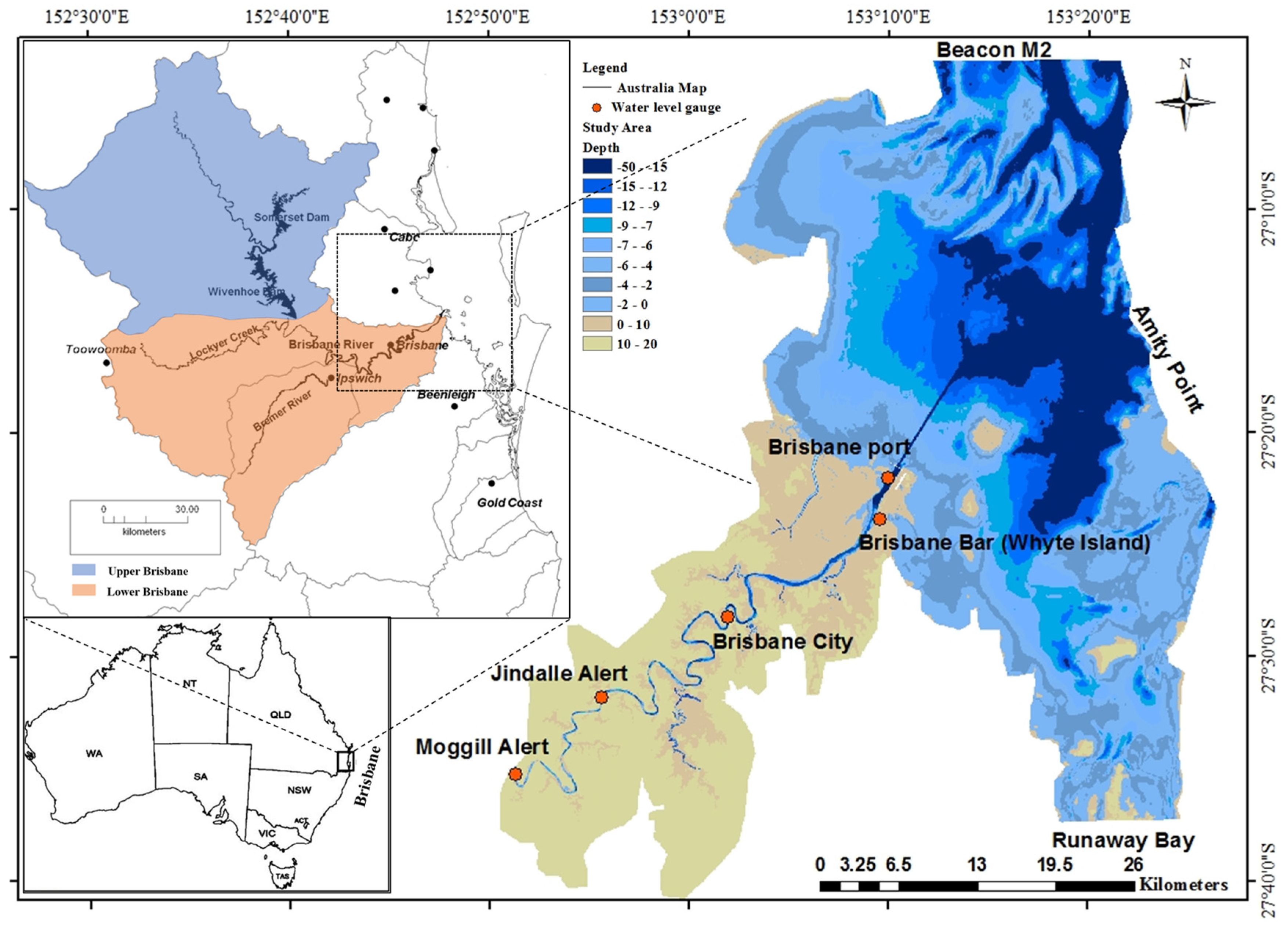
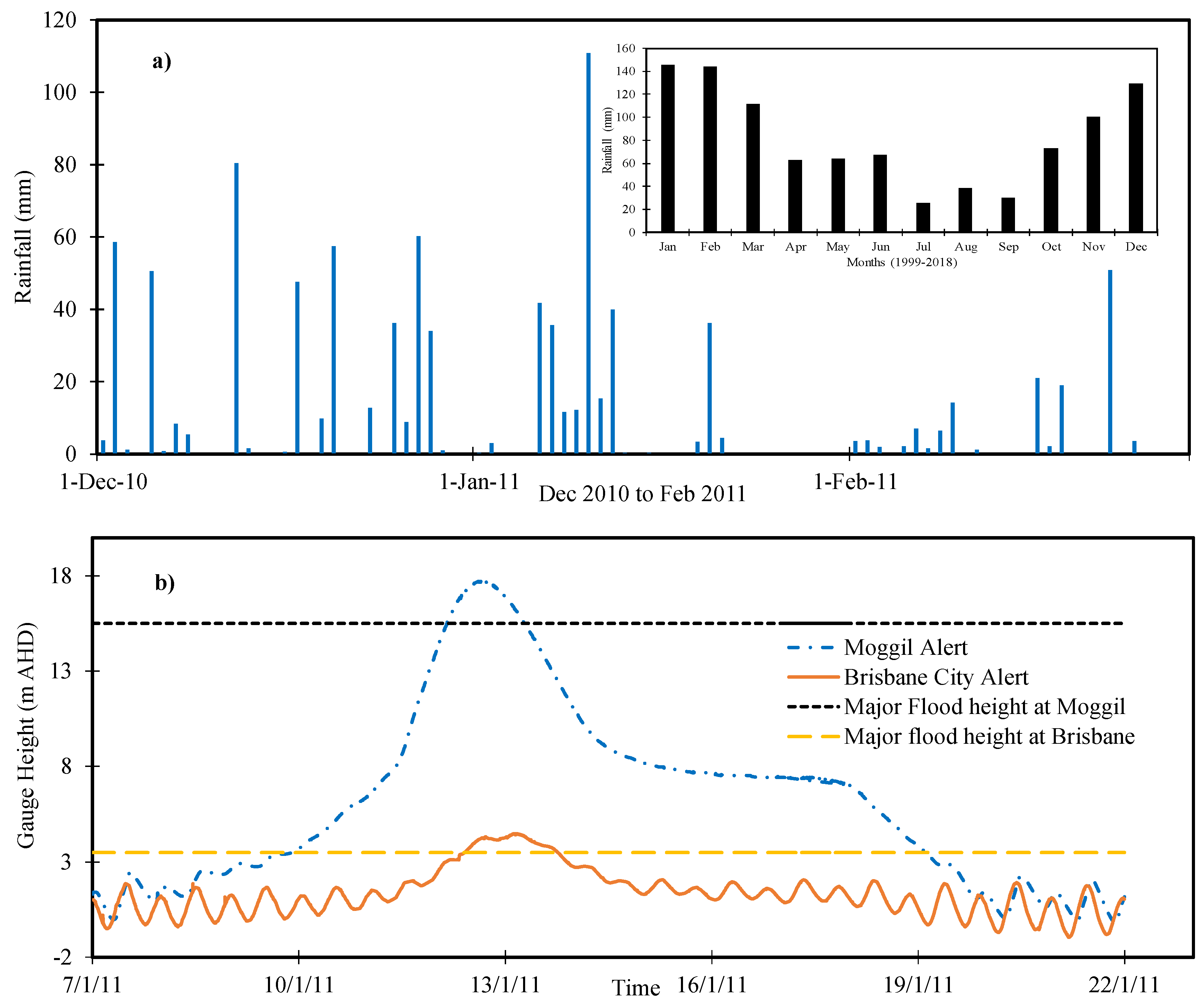
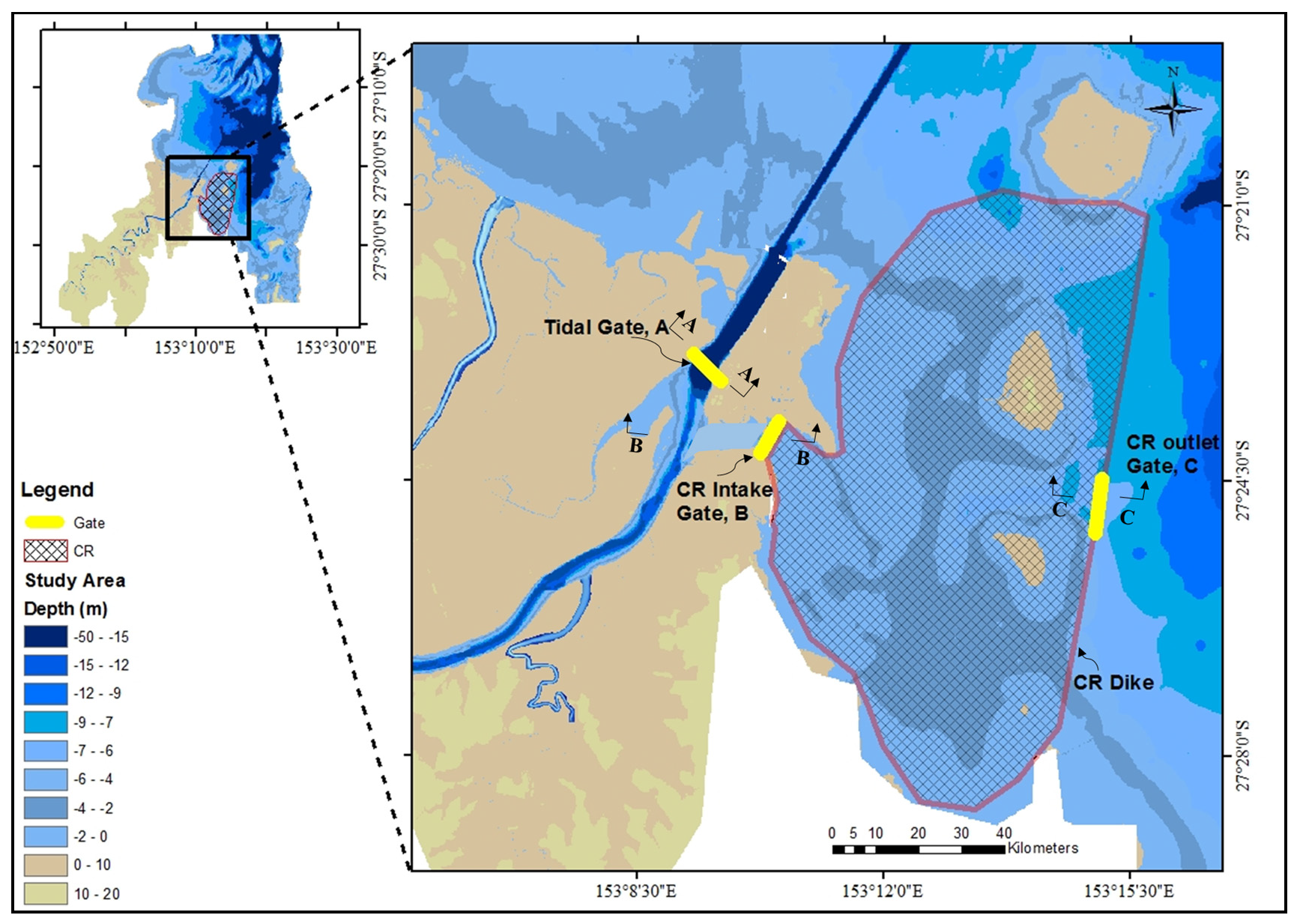
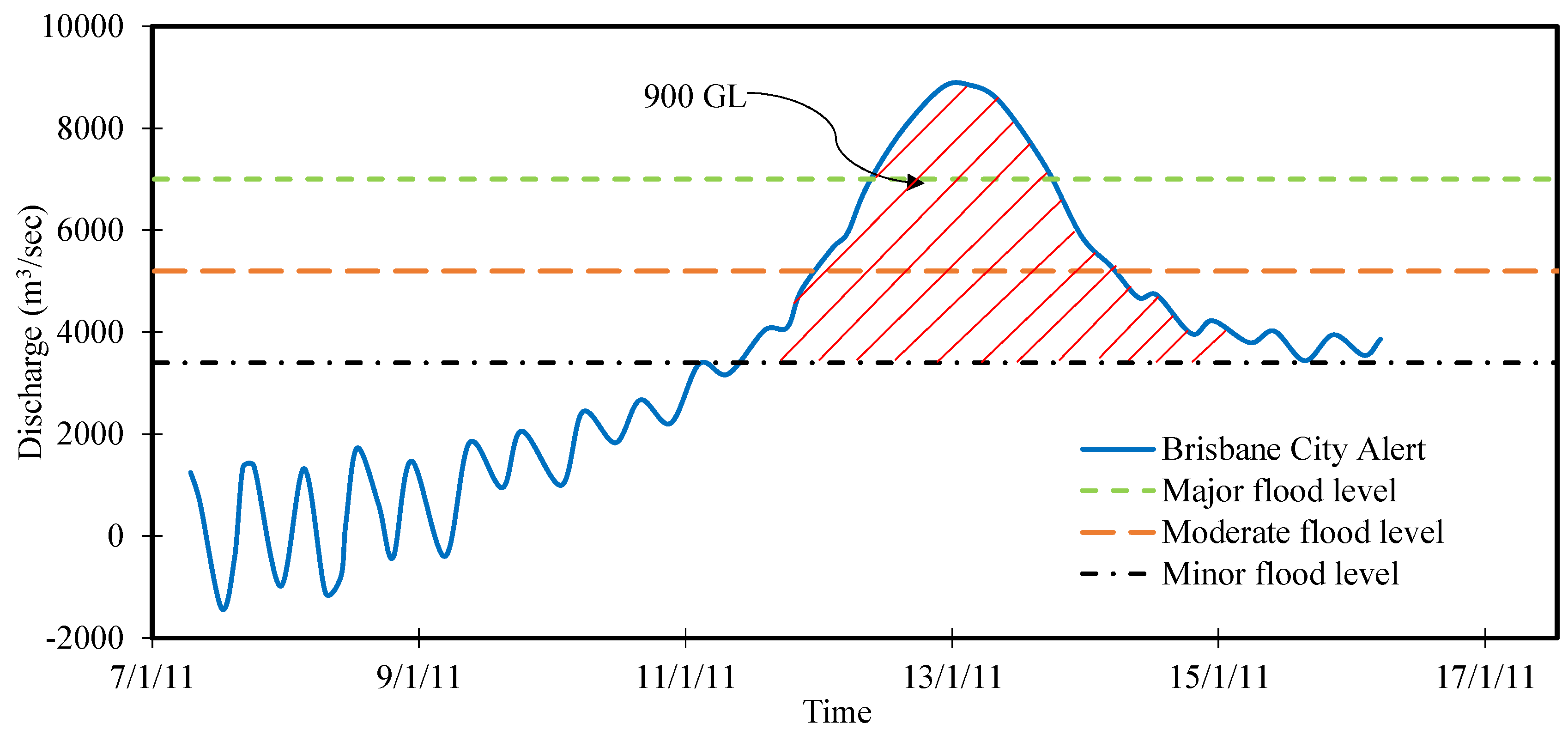
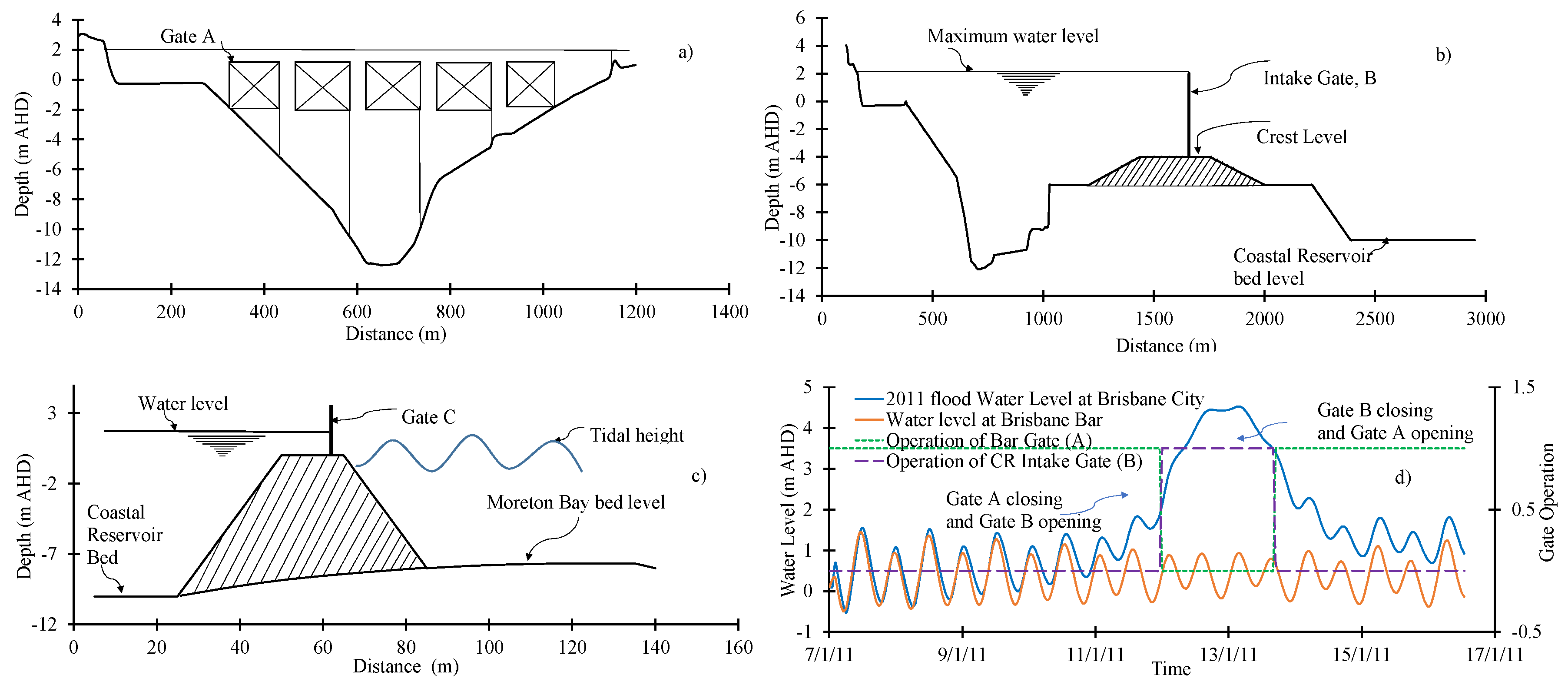
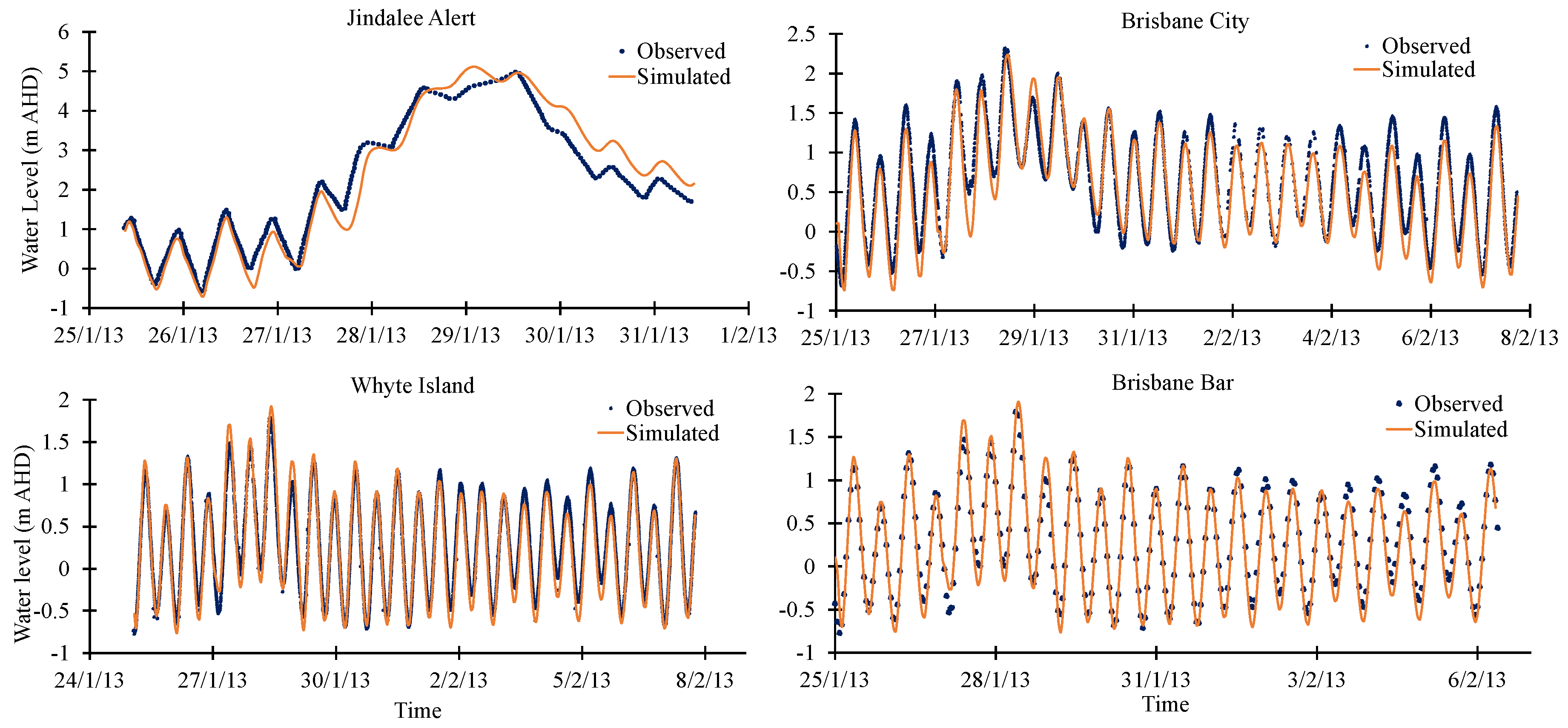
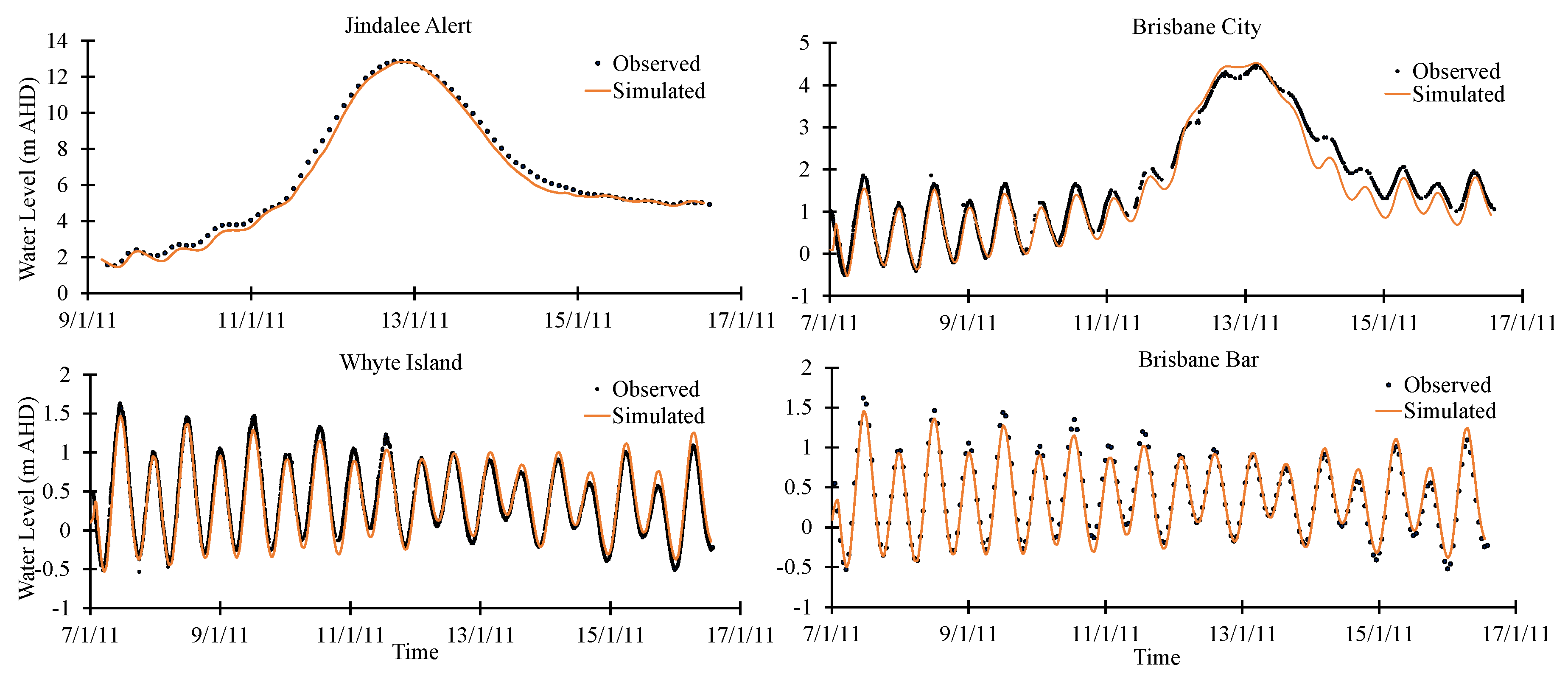
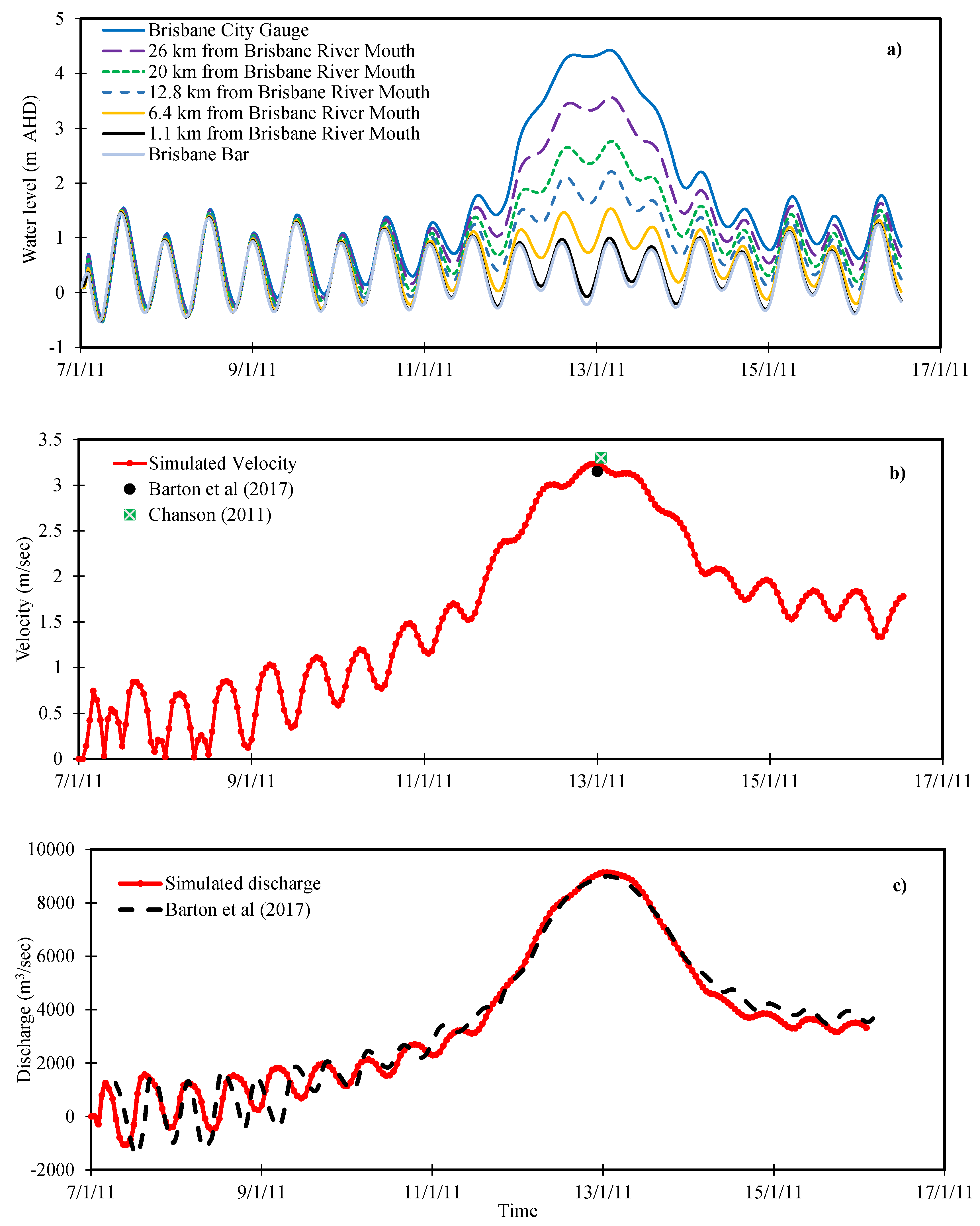
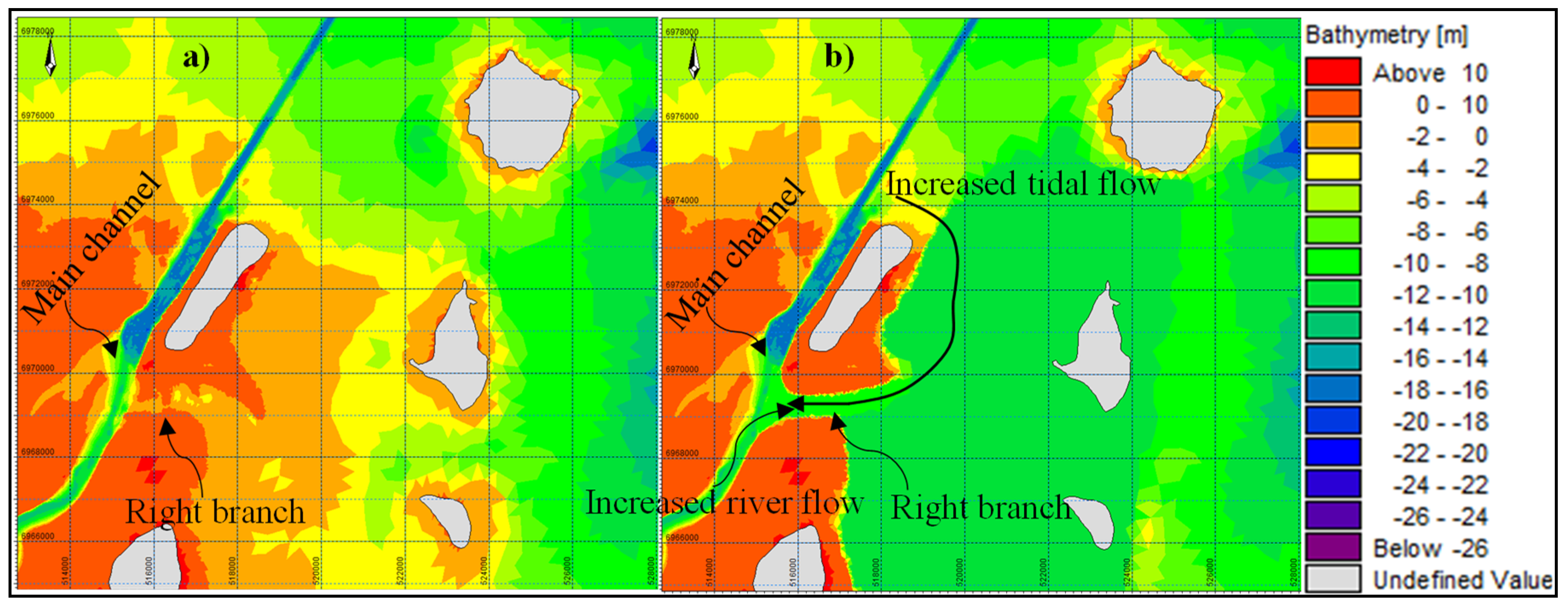
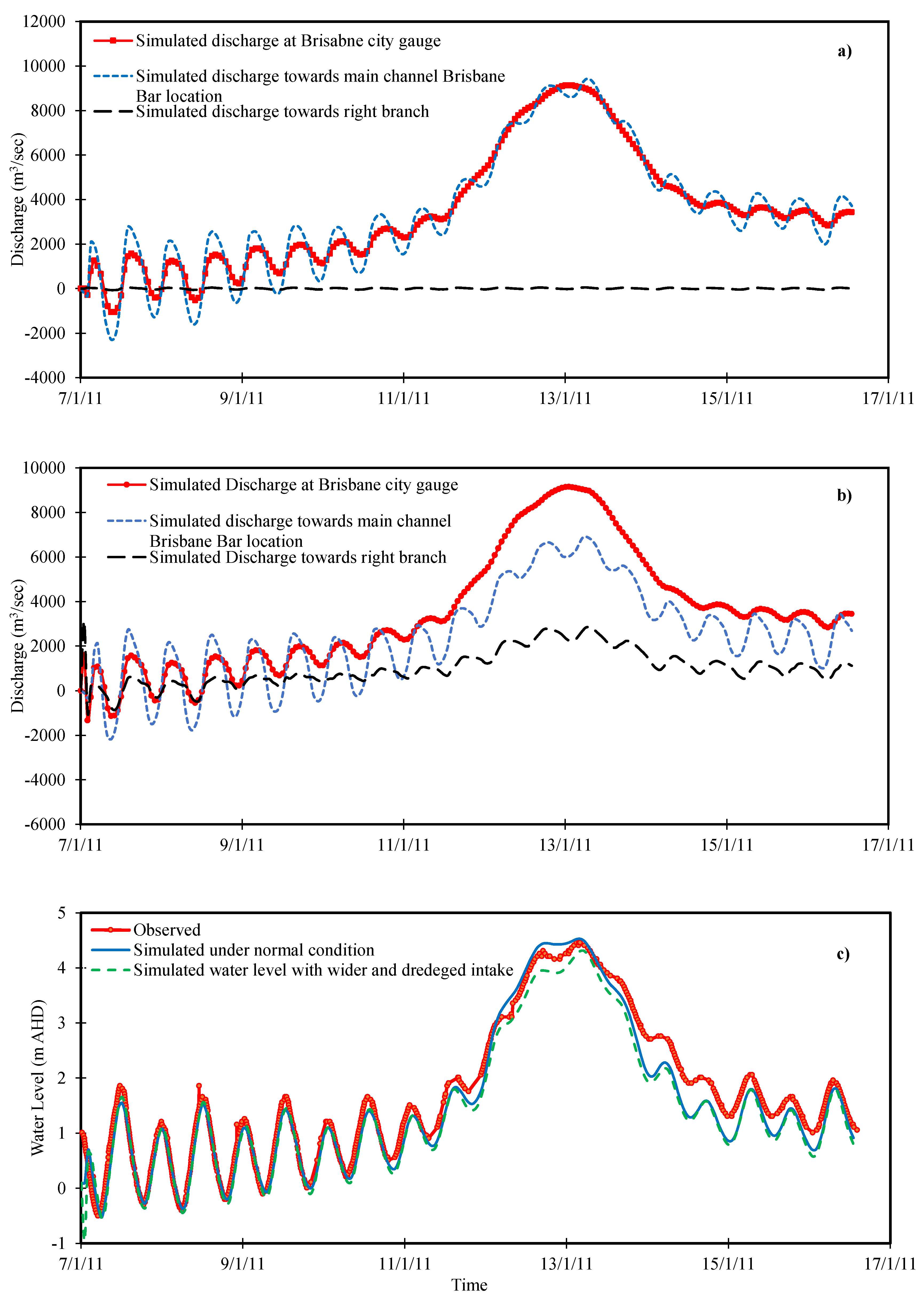
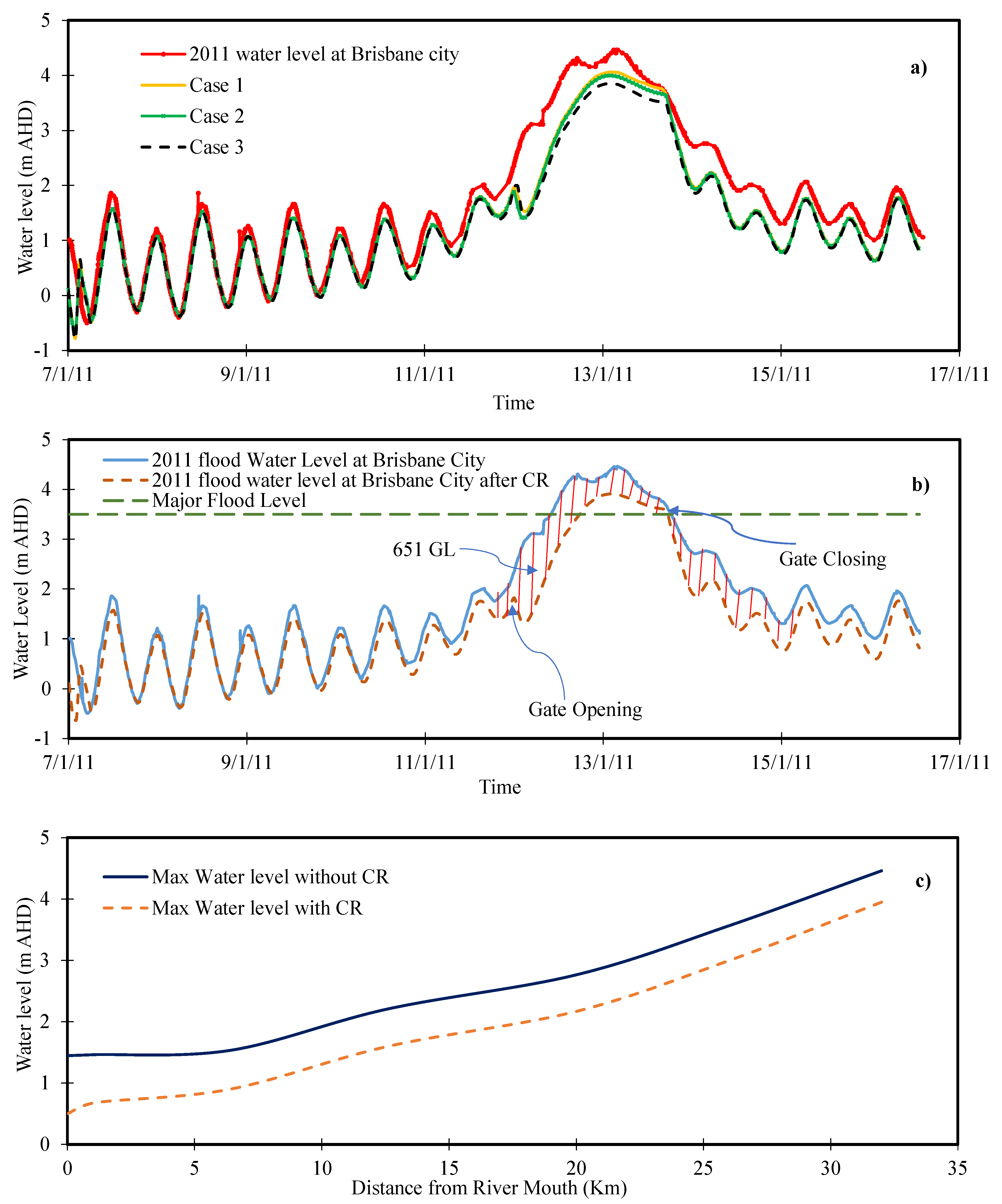
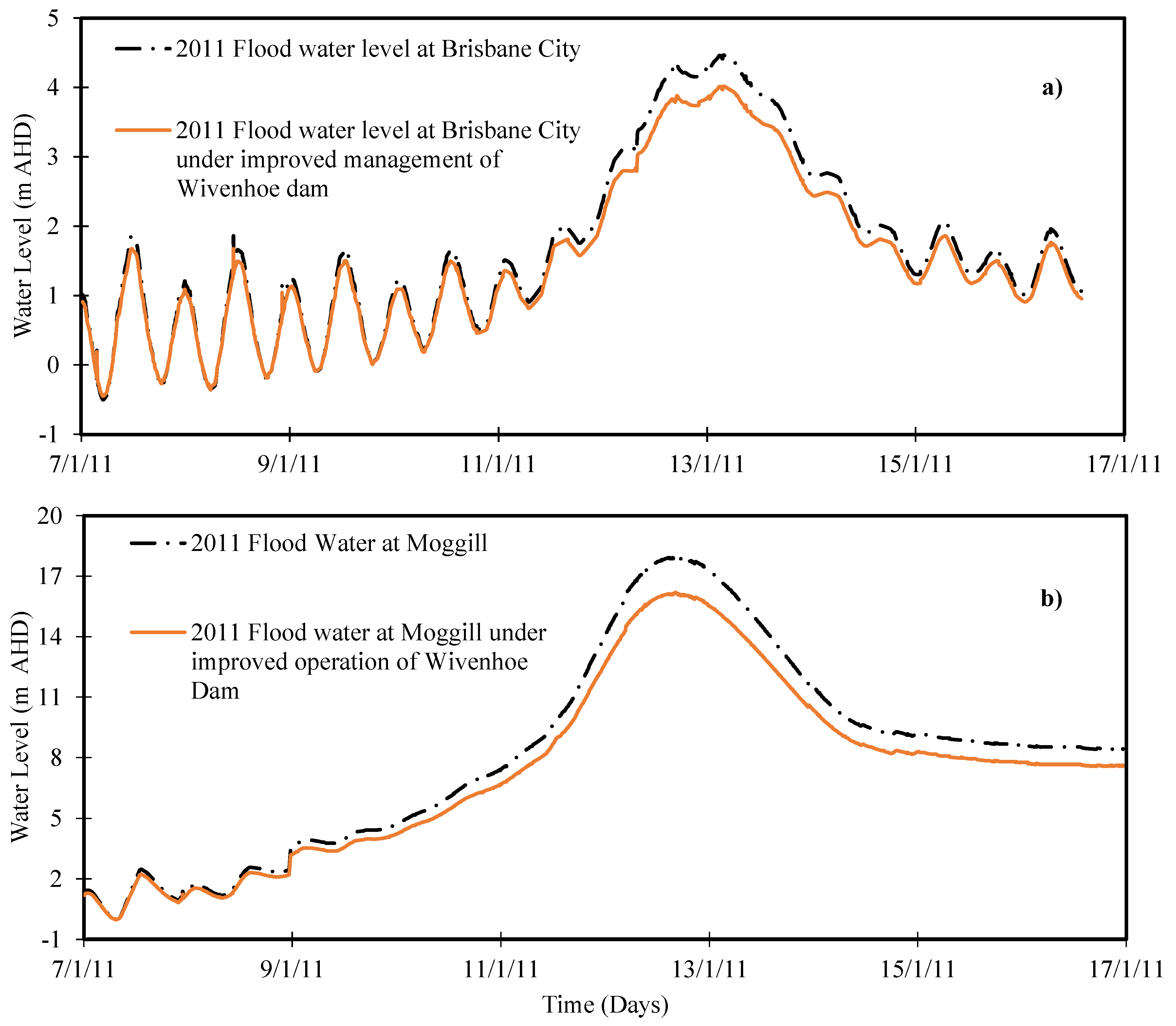
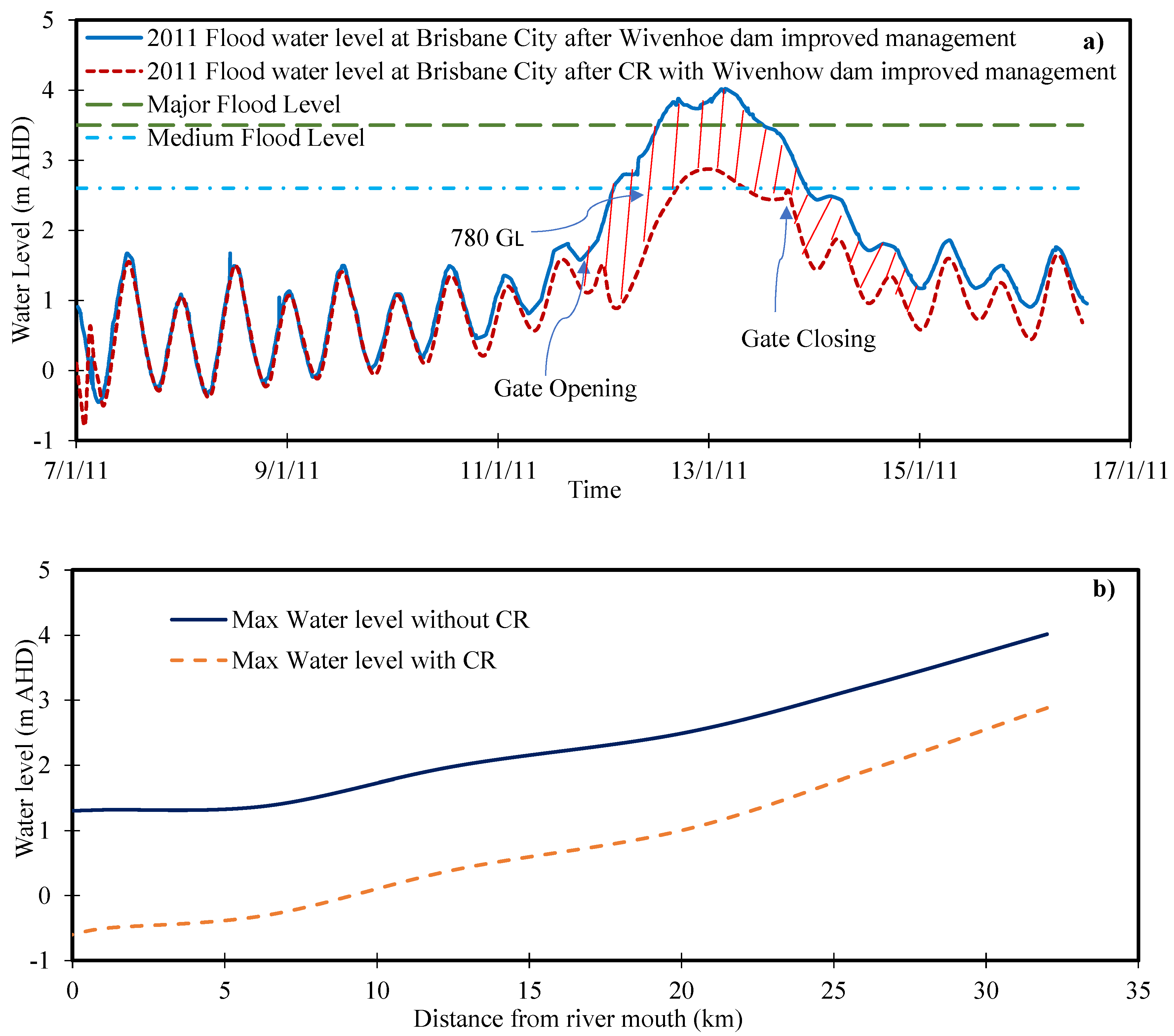
| Flood Event | Water Level (m AHD) | Discharge (m3/s) |
|---|---|---|
| 1841 | 6.51 | 12,500 |
| 1844 | 5.1 | 10,400 |
| 1890 | 3.81 | 8100 |
| 5 February 1893 | 6.83 | 13,700 |
| 19 February 1893 | 6.57 | 12,600 |
| 1898 | 3.5 | 7500 |
| 1974 | 5.45 | 11,300 |
| 2011 | 4.46 | 12,400 |
| 2013 | 2.32 | 4800 |
| Station Number | Latitude | Longitude | Gauge Zero (m) | Datum | Gauging Stations |
|---|---|---|---|---|---|
| 540200 | −27.58° | 152.85° | 0 | AHD | Moggill Alert |
| 046206A | −27.5° | 153.18° | −1.07 | AHD | Beacon M2 Moreton Bay |
| 045100B | −27.54° | 153.24° | −0.62 | AHD | Runaway Bay |
| 046211E | −27.23° | 153.26° | −1.02 | AHD | Amity Point |
| 540192 | −27.53° | 152.92° | 0 | AHD | Jindalee |
| 540198 | −27.47° | 153.03° | 0 | AHD | Brisbane City Alert |
| 046046A | −27.36° | 153.17° | −1.242 | AHD | Brisbane Bar |
| 540495 | −27.40° | 153.16° | 0 | AHD | Whyte Island Alert |
| Model Area | Manning’s n Used in Model | Manning’s n Range ( − ) 1 | Range of Manning’s n ( − ) 2 | Range of Manning’s n ( − ) 3 |
|---|---|---|---|---|
| Moreton Bay | 0.026 | 0.022 | - | 0.02–0.05 |
| Brisbane River: Brisbane Bar—Jindalee | 0.021 | 0.022 | 0.026 | 0.01–0.06 |
| Brisbane River: Jindalee—Moggill | 0.022 | 0.022 | 0.038 | 0.01–0.06 |
| Floodplain | 0.07–0.1 | 0.03–0.1 | 0.091 | 0.02–0.05 |
| Description | Proposed CR at Brisbane River Mouth | Qingcaosha Reservoir a |
|---|---|---|
| Dike length (km) | 34 | 48.41 |
| Area (km2) | 75 | 70 |
| Max. dike height (m) | 15 | 25 |
| Volume (GL) | 900 | 527 |
| Gauging Stations | RMSE | Nash–Sutcliffe Coefficient (Ens) | Maximum Water Level (m AHD) | Dev.in Peak (m) | Percentage Dev. in Peak | |
|---|---|---|---|---|---|---|
| Measured | Simulated | |||||
| Jindalee Alert | 0.405 | 0.979 | 4.976 | 4.962 | 0.014 | 0.281 |
| Brisbane City | 0.216 | 0.877 | 2.29 | 2.235 | 0.055 | 2.402 |
| Brisbane Bar | 0.321 | 0.911 | 1.753 | 1.793 | −0.04 | −2.282 |
| Whyte Island | 0.162 | 0.919 | 1.743 | 1.816 | −0.073 | −4.188 |
| Gauging Stations | RMSE | Nash–Sutcliffe Coefficient (Ens) | Maximum Water Level (m AHD) | Dev.in Peak (m) | Percentage Dev. in Peak | |
|---|---|---|---|---|---|---|
| Measured | Simulated | |||||
| Jindalee Alert | 0.45 | 0.982 | 12.85 | 12.66 | 0.19 | 1.48 |
| Brisbane City | 0.3 | 0.943 | 4.46 | 4.52 | −0.06 | −1.35 |
| Brisbane Bar | 0.1 | 0.952 | 1.62 | 1.45 | 0.167 | 10.32 |
| Whyte Island | 0.115 | 0.941 | 1.61 | 1.47 | 0.144 | 8.95 |
© 2020 by the authors. Licensee MDPI, Basel, Switzerland. This article is an open access article distributed under the terms and conditions of the Creative Commons Attribution (CC BY) license (http://creativecommons.org/licenses/by/4.0/).
Share and Cite
Khalil, U.; Yang, S.-Q.; Sivakumar, M.; Enever, K.; Sajid, M.; Bin Riaz, M.Z. Investigating an Innovative Sea-Based Strategy to Mitigate Coastal City Flood Disasters and Its Feasibility Study for Brisbane, Australia. Water 2020, 12, 2744. https://doi.org/10.3390/w12102744
Khalil U, Yang S-Q, Sivakumar M, Enever K, Sajid M, Bin Riaz MZ. Investigating an Innovative Sea-Based Strategy to Mitigate Coastal City Flood Disasters and Its Feasibility Study for Brisbane, Australia. Water. 2020; 12(10):2744. https://doi.org/10.3390/w12102744
Chicago/Turabian StyleKhalil, Usman, Shu-Qing Yang, Muttucumaru Sivakumar, Keith Enever, Mariam Sajid, and Muhammad Zain Bin Riaz. 2020. "Investigating an Innovative Sea-Based Strategy to Mitigate Coastal City Flood Disasters and Its Feasibility Study for Brisbane, Australia" Water 12, no. 10: 2744. https://doi.org/10.3390/w12102744
APA StyleKhalil, U., Yang, S.-Q., Sivakumar, M., Enever, K., Sajid, M., & Bin Riaz, M. Z. (2020). Investigating an Innovative Sea-Based Strategy to Mitigate Coastal City Flood Disasters and Its Feasibility Study for Brisbane, Australia. Water, 12(10), 2744. https://doi.org/10.3390/w12102744





